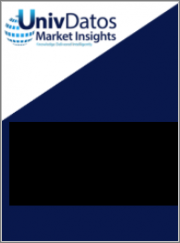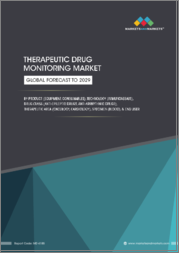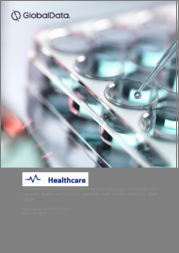
|
시장보고서
상품코드
1290937
치료제 모니터링(TDM) 시장 : 현황 분석 및 예측(2022-2022년)Therapeutic Drug Monitoring Market: Current Analysis and Forecast (2022-20230) |
||||||
치료제 모니터링(TDM) 시장은 2022-2030년간 약 10%의 CAGR을 나타낼 것으로 예상됩니다. 치료제 모니터링(TDM)은 환자의 혈액 및 기타 체액의 약물 농도를 측정하여 약물 치료의 효과와 안전성을 극대화하는 것으로, TDM의 목적은 환자가 연령, 체중, 유전 및 기타 의학적 문제와 같은 개인적 특성에 따라 올바른 약물 복용량을 받도록 하는 것입니다. TDM은 치료 범위가 좁은 약물, 즉 약물의 최소 유효 농도와 위험 농도 사이에 약간의 간격이 있는 약물에 자주 사용됩니다. 의료진은 약물 농도를 모니터링함으로써 치료 효과를 얻기 위해 필요한 용량과 투여 빈도를 변경하여 부작용 위험을 최소화할 수 있습니다. 약물 모니터링에 대한 수요가 증가하는 배경에는 세계적으로 암, 당뇨병, 심장병과 같은 만성질환의 유병률이 증가하고 있기 때문입니다. 예를 들어, CDC에 따르면 20세 이상의 미국인 중 약 1,800만 명이 심장병을 앓고 있으며, 매년 65만 명에 가까운 사람들이 심장병으로 사망하고 있습니다. 이러한 통계를 통해 볼 때, 치료제 모니터링은 암, 당뇨병, 심혈관 질환 등 장기간 약물 치료가 필요한 만성 질환을 앓고 있는 환자들의 약물 치료를 줄이고 최적화하는 데 기여하며, 향후 시장 성장에 기여할 것으로 보입니다. 또한, 의료진의 인식이 높아짐에 따라 치료제 모니터링(TDM) 시장은 성장할 것으로 예상됩니다. 그러나 높은 기기 비용과 엄격한 규제 등 시장 성장 억제요인이 세계 시장 성장을 저해하는 요인으로 작용하고 있습니다.
제품 유형에 따라 시장은 소모품 및 장비로 분류됩니다. 이 중 소모품 부문은 2021년 시장에서 큰 비중을 차지했습니다. 이는 만성 질환의 유병률 증가로 인해 이 부문을 견인하고 있기 때문입니다. 또한, 신기술 기반의 비용 효율적인 키트에 대한 수요 증가와 연구 및 개발 분야에서 시약의 사용도 이 부문 시장 성장을 가속하고 있습니다.
기술에 따라 시장은 면역 분석, 단백질 기술 및 기타로 나뉩니다. 이 중 면역 분석 분야는 높은 CAGR을 기록할 것으로 예상됩니다. 이는 특이성과 신뢰성이 높은 면역 분석의 가용성으로 인해 이 분야의 성장을 가속할 것으로 보입니다. 또한, 첨단 기술의 채택률 증가와 장비 사용에 대한 최소한의 교육이 필요하다는 점도 이 부문의 성장을 가속하고 있습니다.
치료제 모니터링(TDM) 시장은 약물 유형에 따라 항경련제, 항생제, 면역억제제, 진정제, 항부정맥제로 분류됩니다. 이 중 항간질제 부문이 상당한 시장 점유율을 차지하고 있으며, 예측 기간 동안 높은 CAGR로 성장할 것으로 예상됩니다. 간질과 발작의 유병률 증가가 이 부문의 성장 동력이 되고 있습니다. 또한, 항간질약의 수가 증가함에 따라 이 부문의 성장을 가속할 것으로 예상됩니다.
치료제 모니터링(TDM) 시장은 최종 사용자에 따라 병원 실험실, 개인 실험실 및 기타로 분류됩니다. 이 중 시장 세분화에서 병원 실험실 부문은 더 높은 CAGR로 성장할 것으로 예상됩니다. 이는 병원에서 연령, 대사, 민족성, 약물 사용 이력 등과 같은 정확한 환자 정보를 얻을 수 있기 때문에 이 부문의 성장을 가속하고 있기 때문입니다. 또한, 환자의 병력 및 정보 기록을 컴퓨터로 입력할 수 있는 기회가 증가하면서 이 시장의 성장을 가속하고 있습니다.
치료제 모니터링(TDM) 시장 서론에 대한 이해를 돕기 위해 북미(미국, 캐나다, 기타 북미), 유럽(독일, 프랑스, 이탈리아, 스페인, 영국, 기타 유럽), 아시아태평양(중국, 일본, 인도, 기타 APAC 지역) 및 기타 지역별로 분석했습니다. 치료제 모니터링은 여러 가지 요인으로 인해 북미에서 인기가 높아지고 있습니다. 암과 같은 만성 질환의 유병률 증가는 이 지역의 약물 모니터링 시장 수요를 증가시키고 있습니다. 의료 서비스 제공업체가 환자별 약동학 및 약력학 프로파일을 기반으로 환자 개개인에게 맞춤화된 약물 요법을 제공할 수 있게 됨에 따라 맞춤형 의료에 대한 수요 증가가 TDM의 주요 요인으로 작용하고 있습니다. 또한, 기술 발전도 치료제 모니터링(TDM) 시장의 성장 요인으로 작용하고 있습니다. 예를 들어, 2020년 6월 Quest Diagnostics는 면역억제제인 미코페놀산의 새로운 치료제 모니터링 테스트를 출시했으며, TDM을 촉진하기 위한 정부 이니셔티브 증가는 이 지역 시장 성장을 더욱 촉진했습니다.
목차
제1장 시장 서론
- 시장의 정의
- 주요 목적
- 이해관계자
- 제한 사항
제2장 조사 방법 또는 전제조건
- 조사 과정
- 조사 방법
- 응답자 개요
제3장 시장 요약
제4장 주요 요약
제5장 COVID-19가 치료제 모니터링(TDM) 시장에 미치는 영향
제6장 세계의 치료제 모니터링(TDM) 시장 매출, 2020-2030년
제7장 시장 인사이트 : 제품 유형별
- 소모품
- 기기
제8장 시장 인사이트 : 기술별
- 면역분석법
- 프로테오믹스 기술
- 기타
제9장 시장 인사이트 : 약물 클래스별
- 항간질약
- 항생제
- 면역억제제
- 향정신성
- 항부정맥제
제10장 시장 인사이트 : 최종사용자별
- 병원 실험실
- 민간 실험실
- 기타
제11장 시장 인사이트 : 지역별
- 북미의 치료제 모니터링(TDM) 시장
- 미국
- 캐나다
- 기타 북미
- 유럽의 치료제 모니터링(TDM) 시장
- 독일
- 프랑스
- 영국
- 스페인
- 이탈리아
- 기타 유럽
- 아시아태평양의 치료제 모니터링(TDM) 시장
- 중국
- 일본
- 인도
- 기타 아시아태평양
- 기타 지역의 치료제 모니터링(TDM) 시장
제12장 치료제 모니터링(TDM) 시장 역학
- 시장 성장 촉진요인
- 시장이 해결해야 할 과제
- 영향 분석
제13장 치료제 모니터링(TDM) 시장 기회
제14장 치료제 모니터링(TDM) 시장 동향&인사이트
제15장 수요측과 공급측 분석
- 수요측 분석
- 공급측 분석
제16장 밸류체인 분석
제17장 가격 분석
제18장 전략적 인사이트
제19장 경쟁 시나리오
- 경쟁 구도
- Porter의 Five Forces 분석
제20장 기업 개요
- Roche AG
- Siemens Healthcare GmbH
- Thermo Fisher Scientific, Inc.
- Bio-Rad Laboratories, Inc.
- Beckman Coulter, Inc.
- Abbott Laboratories, Inc.
- Agilent Technologies, Inc.
- bioMerieux, Inc.
- Bayer AG
- Alere, Inc
제21장 면책사항
LSH 23.07.26The therapeutic drug monitoring market is expected to register a CAGR of approx. 10% over the period of 2022-2030. Therapeutic drug monitoring (TDM) measures drug concentrations in a patient's blood or other bodily fluids to maximize the efficacy and security of pharmacological therapy. TDM's purpose is to guarantee that a patient receives the correct medicine dose depending on individual characteristics such as age, weight, genetics, and other medical problems. TDM is commonly employed for medications with a narrow therapeutic range, which means there is a tiny gap between the drug's minimum effective concentration and hazardous concentration. Healthcare practitioners can alter the amount or frequency of delivery as needed to achieve the intended therapeutic benefit while minimizing the risk of unwanted effects by monitoring medication levels. The growing demand for therapeutic drug monitoring can be attributed to the rising prevalence of chronic diseases such as cancer, diabetes, cardiovascular disease, etc. across the globe. For instance, according to the CDC, around 18 million Americans aged 20 and above have heart disease and nearly 650,000 Americans die of heart disease each year. Owing to the glaring statistics therapeutic drug monitoring help to reduce or optimize drug therapy in the patient suffering from chronic diseases such as cancer, diabetes, and cardiovascular disease, etc. which require long-term drug therapy which would contribute to the growth of the market in the forthcoming period as well. Furthermore, the therapeutic drug monitoring market is anticipated to grow on account of the increasing awareness among healthcare professionals. However, some of the restraints in the market, including the high cost of the equipment and stringent regulations are impeding the growth of this market all over the world.
Based on product type, the market is segmented into consumables and devices. Among them, the consumables segment captured a significant share of the market in 2021. This is due to the increasing prevalence of chronic diseases which is boosting this segment. Moreover, the increasing demand for new technology-based, cost-effective kits and the use of reagents in the R&D area is also boosting the growth of the segment of the market.
Based on the technology, the market is bifurcated into immunoassays, proteomic technologies, and others. Among them, the immunoassays segment is expected to grow at a higher CAGR in the market. This is due to the availability of highly specific and reliable immunoassay which is likely to aid the growth of the segment. Moreover, the rising adoption rate of advanced techniques and the requirement of minimal training to handle the equipment also boosted the growth of the segment.
Based on the drug class, the therapeutic drug monitoring market has been classified as anti-epileptics, antibiotics, immunosuppressants, psychoactive, and anti-arrhythmic drugs. Among them, the anti-epileptics category grabbed a considerable market share, and it is expected to grow at a significant CAGR during the forecast period. The increasing prevalence of epilepsy and seizures are the factors that help in boosting the segment. Moreover, the rising growth in the number of Anti-epileptic drugs is also likely to aid the segment growth.
Based on the end-user, the therapeutic drug monitoring market has been classified as hospital labs, private labs, and others. Among them, the hospital labs segment is expected to grow at a higher CAGR in the market. This is due to the availability of accurate patient information, such as age, metabolism, ethnicity, and drug performance history in the hospitals which boost the segment growth. Moreover, the increasing use of computerized entry of patient history and information records is more likely to boost the growth of the market segment.
For a better understanding of the market adoption of therapeutic drug monitoring, the market is analyzed based on its worldwide presence in the countries such as North America (U.S., Canada, and the Rest of North America), Europe (Germany, France, Italy, Spain, U.K., and Rest of Europe), Asia-Pacific (China, Japan, India, and Rest of APAC), and Rest of World. Therapeutic drug monitoring has gained increasing popularity in North America due to various factors. The increasing prevalence of chronic diseases such as cancer, etc. is boosting the demand for the therapeutic drug monitoring market in this region. The growing demand for personalized medicine is becoming the highlight for TDM as it allows healthcare providers to tailor drug therapy to individual patients based on their unique pharmacokinetic and pharmacodynamics profiles. The advancement in technology is also attributed to the growth of the therapeutic drug monitoring market. For instance, In June 2020, Quest Diagnostics launched a new therapeutic drug monitoring test for the immunosuppressive drug, Mycophenolic Acid. Increasing government initiatives to promote TDM further boosted the growth of the market in the region.
Some of the major players operating: Roche AG, Siemens Healthcare GmbH, Thermo Fisher Scientific, Inc., Bio-Rad Laboratories, Inc., Beckman Coulter, Inc., Abbott Laboratories, Inc., Agilent Technologies, Inc., bioMerieux, Inc., Bayer AG, Alere, Inc among others. Several M&A's along with partnerships have been undertaken.
TABLE OF CONTENTS
1 MARKET INTRODUCTION
- 1.1. Market Definitions
- 1.2. Main Objective
- 1.3. Stakeholders
- 1.4. Limitation
2 RESEARCH METHODOLOGY OR ASSUMPTION
- 2.1. Research Process of the Therapeutic Drug Monitoring Market
- 2.2. Research Methodology of the Therapeutic Drug Monitoring Market
- 2.4. Respondent Profile
3 MARKET SYNOPSIS
4 EXECUTIVE SUMMARY
5 IMPACT OF COVID-19 ON THE THERAPEUTIC DRUG MONITORING MARKET
6 GLOBAL THERAPEUTIC DRUG MONITORING MARKET REVENUE, 2020-2030F
7 MARKET INSIGHTS BY PRODUCT TYPE
- 7.1. Consumables
- 7.2. Devices
8 MARKET INSIGHTS BY TECHNOLOGY
- 8.1. Immunoassays
- 8.2. Proteomic Technologies
- 8.3. Others
9 MARKET INSIGHTS BY DRUG CLASS
- 9.1. Anti-Epileptics
- 9.2. Antibiotics
- 9.3. Immunosuppressants
- 9.4. Psychoactive
- 9.5. Anti-Arrhythmic Drugs
10 MARKET INSIGHTS BY END-USER
- 10.1. Hospital Labs
- 10.2. Private Labs
- 10.3. Others
11 MARKET INSIGHTS BY REGION
- 11.1 NORTH AMERICA THERAPEUTIC DRUG MONITORING MARKET
- 11.1.1 United States
- 11.1.2 Canada
- 11.1.3 Rest of North America
- 11.2 EUROPE THERAPEUTIC DRUG MONITORING MARKET
- 11.2.1 Germany
- 11.2.2 France
- 11.2.3 United Kingdom
- 11.2.4 Spain
- 11.2.5 Italy
- 11.2.6 Rest of Europe
- 11.3 ASIA PACIFIC THERAPEUTIC DRUG MONITORING MARKET
- 11.3.1 China
- 11.3.2 Japan
- 11.3.3 India
- 11.3.4 Rest of Asia Pacific
- 11.4 REST OF THE WORLD THERAPEUTIC DRUG MONITORING MARKET
12 THERAPEUTIC DRUG MONITORING MARKET DYNAMICS
- 12.1 Market Drivers
- 12.2 Market Challenges
- 12.3 Impact Analysis
13 THERAPEUTIC DRUG MONITORING MARKET OPPORTUNITIES
14 THERAPEUTIC DRUG MONITORING MARKET TRENDS & INSIGHTS
15 DEMAND AND SUPPLY SIDE ANALYSIS
- 15.1 Demand Side Analysis
- 15.2 Supply Side Analysis
16 VALUE CHAIN ANALYSIS
17 PRICING ANALYSIS
18 STRATEGIC INSIGHTS
19 COMPETITIVE SCENARIO
- 19.1. Competitive Landscape
- 19.1.1 Porter's Five forces analysis
20 COMPANY PROFILED
- 20.1. Roche AG
- 20.2. Siemens Healthcare GmbH
- 20.3. Thermo Fisher Scientific, Inc.
- 20.4. Bio-Rad Laboratories, Inc.
- 20.5. Beckman Coulter, Inc.
- 20.6. Abbott Laboratories, Inc.
- 20.7. Agilent Technologies, Inc.
- 20.8. bioMerieux, Inc.
- 20.9. Bayer AG
- 20.10. Alere, Inc



















